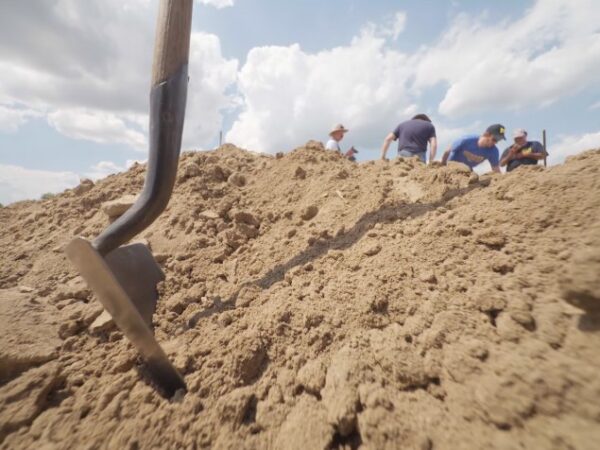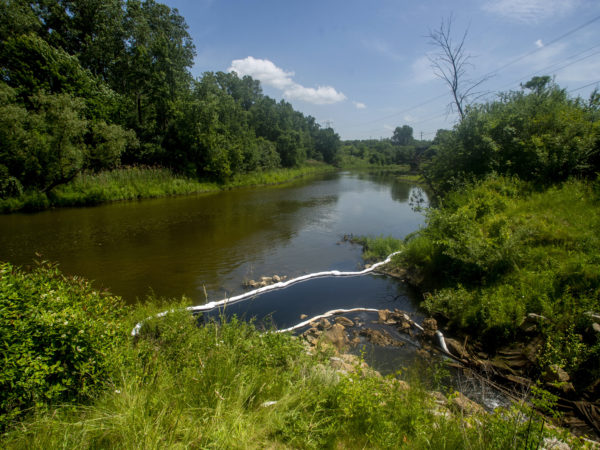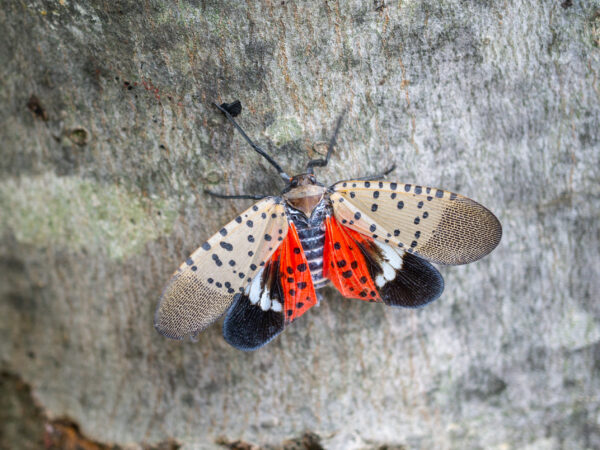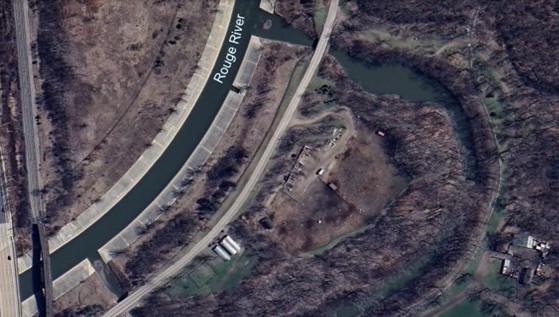
Great Lakes Moment is a monthly column written by Great Lakes Now Contributor John Hartig. Publishing the author’s views and assertions does not represent endorsement by Great Lakes Now or Detroit PBS.
In the 1960s, an oxbow was eliminated in the lower Rouge River when a concrete channel was built to move stormwater out of the watershed. Today, this former oxbow has been restored and is being used to enhance education at The Henry Ford in Dearborn, Michigan.
As many rivers descend from their headwaters and reach lower-lying land near their mouth, they often swing from side to side, forming winding bends called meanders. An oxbow is a severe bend in a river creating a U-shaped channel and leaving a very narrow strip of land between the two bends. Often, erosion will wear through this narrow strip and the course of the river changes, leaving a U-shaped oxbow lake.
Historically, an oxbow existed on the lower Rouge River adjacent to The Henry Ford, a National Historic Landmark consisting of its Museum of American Innovation and Greenfield Village in Dearborn, Michigan. Starting in 1962, the U.S. Army Corps of Engineers initiated a massive flood control project that constructed a 4.2-mile concrete channel to move as much stormwater out of this section of the watershed as fast as possible. At that time, there was considerable flooding in the communities of Dearborn, Allen Park, Melvindale and others, so much that stormwater and wastewater were backing up in basements of homes and creating a health hazard. This flooding also threatened Fairlane Town Center, a large nearby shopping mall.
Construction of this concrete channel straightened the river and reduced the length in this portion of the river from 5.8 miles of natural river to 4.2 miles of a concrete-lined channel. The channelization also eliminated all river habitats through its course and disconnected that area from public access. Meanders, riffles, pools, floodplains and an oxbow adjacent to The Henry Ford were eliminated in favor of a nearly straight, smooth and wide concrete channel. And with this, all ecological benefits were lost. For example, the concrete channel inhibited fish migrations upstream from the Detroit River during high spring river flows because of a lack of fish resting areas in the channel and inhibited fish passage during low-velocity summer months because of low dissolved oxygen in the river.
As controls of combined sewer overflows (where stormwater and raw sewage are discharged during heavy rainfall events) and urban stormwater runoff were implemented beginning in the late 1980s and 1990s, people began reimagining restoring this historical oxbow as an ecological, educational and cultural asset.
The Rouge River oxbow restoration project began in 2002 through a collaboration between Wayne County, The Henry Ford, Rouge River Gateway Partnership, Rouge River Advisory Council, the University of Michigan-Dearborn, Ford Motor Company, the City of Dearborn, the U.S. Army Corps of Engineers, the Michigan Department of Environment, Great Lakes and Energy, Alliance of Rouge Communities, Friends of the Rouge and others. The project was completed in three phases over 17 years at a cost of over $3 million.
Phase 1 included restoring the 2,200-foot channel at a 16-105-foot width with 3-7-foot depths. In total, more than 7,000 yards of concrete and debris were removed, and 13 acres of wetland and upland habitats were restored in this phase. Phase 2 re-established a partial connection between the oxbow and the river in 2005. Phase 3 completed full connection with the Rouge River and restored natural flows in 2018-2019.
“The Rouge River oxbow restoration is an example of the excellent work being done in Michigan Areas of Concern through public-private partnerships,” said Brian James Egen, chair of the Michigan Statewide Public Advisory Council. “Such projects as this oxbow restoration are catalyzing reconnecting people to the Great Lakes and their tributaries through greenways and water trails that will lead to community revitalization. This project is truly inspirational.”
Benefits of restoring this oxbow are wide-ranging. You must remember that when the oxbow was filled in, all the fish lost important habitats required to complete their life cycle. Today, the oxbow provides important nursery habitat for numerous species of fish. Friends of the Rouge fish sampling (using seines and dipnets) in the oxbow during 2020 found 1,025 individuals representing 22 species – bluegill was the most common. This shows that the oxbow is a refuge and habitat for resident and migrating fish.
Fishery biologists from the Michigan Department of Natural Resources periodically perform electrofishing (a fishing technique that uses an electric current to stun and collect fish) surveys to document the status and health of the fishery. In July 2022, fishery biologists collected 137 total fish representing 17 species inside the oxbow channel through electrofishing, compared to only 27 total fish representing four species in the concrete channel. This shows that fish abundance in the oxbow was roughly five times greater in the concrete channel and species richness (number of species) was over four times greater.
“The restored oxbow channel provides extremely valuable habitat diversity for many aquatic and terrestrial species, particularly resting, foraging, spawning and nursery areas for fish which are very limited in this stretch of the river,” said John Buszkiewicz, fishery biologist with the Michigan Department of Natural Resources.
The oxbow’s natural shoreline and muddy bottom also provide much-needed habitat for native amphibians and reptiles, such as basking logs, woody aquatic structures, hibernacula (winter quarters for animals) sites and nesting locations. Invertebrates living in the bottom sediments of the oxbow also benefit from improved habitats. This project also incorporated native seed plantings that benefit pollinators and achieve streambank stabilization. Naturalists have reported diverse wildlife sightings throughout the restored uplands and wetlands, including coyote, fox, raccoon, deer, raptors, owls, bats, ducks, herons, turtles and frogs.
The Henry Ford recognizes the historical significance of the Rouge River oxbow. Dr. Debra Reid, curator of agriculture and the environment at The Henry Ford, said, “The oxbow acts as a prod, reminding us always of the scale of human-environment interactions over time and the need to respect and preserve the natural. It takes center stage in an environmental history of Henry Ford, a project in its initial phases.”
Reid explained, “The oxbow reflects centuries of change, rethinking, and regeneration.” Another example of this evolution is Clara and Henry Ford’s estate called Fair Lane, located just upstream of the oxbow. This estate is on the national register of historic places and includes lush gardens designed by famed landscape architect Jens Jensen. Ford also built a dam and hydroelectric power plant at the river estate that blocked fish migrations. Recently, a fishway was constructed around the power plant dam that allows fish passage.
The oxbow is also part of the story of how Henry Ford revolutionized the automobile industry, influenced how people lived through his mass production techniques and the assembly line and promoted resource conservation. Examples of resource conservation include Ford’s vision of “ore to assembly” at the Rouge Plant, renewable energy from hydroelectric power, his “one foot in industry and one foot in agriculture” – soybean the “miracle bean;” and his Upper Peninsula operations to supply wood to build cars. Today, Ford Motor Company is a leader in sustainability as demonstrated through its Ford Rouge Plant on the banks of the Rouge River and its new research and technology hub centered in Detroit’s newly restored Central Train Station that will focus on developing, testing, and launching urban transportation solutions.
“The Rouge River oxbow reminds us that work continues to reverse consequences of such mechanization,” Reid said. “This natural feature has already become a teachable moment for resource conservation, ecosystem restoration and sustainability at The Henry Ford, and we look forward to building opportunities for formal and information education and interpretation, taking inspiration from the oxbow, in the future.”
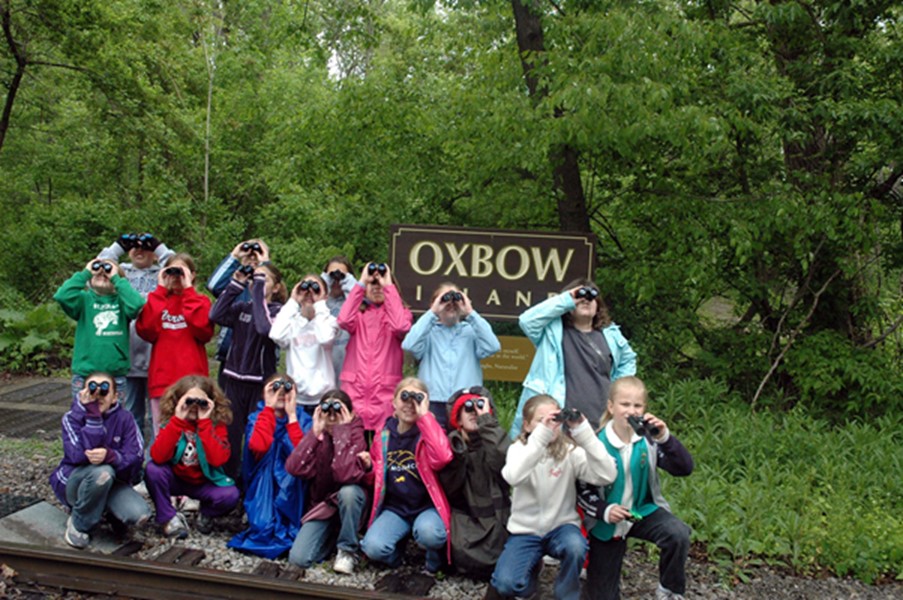
The Rouge River oxbow has been used for Girl Scout field trips (credit: Brian James Egen).
John Hartig is a board member at the Detroit Riverfront Conservancy. He serves as a Visiting Scholar at the University of Windsor’s Great Lakes Institute for Environmental Research and has written numerous books and publications on the environment and the Great Lakes. Hartig also helped create the Detroit River International Wildlife Refuge, where he worked for 14 years as the refuge manager.
Catch more news at Great Lakes Now:
Great Lakes Moment: Connecting people to nature through The Great Lakes Way
Great Lakes Moment: Michigan’s Port of Monroe fosters a blue economy that welcomes wildlife
Featured image: The restored Rouge River oxbow adjacent to The Henry Ford, Dearborn, Michigan (credit: Google Earth).


